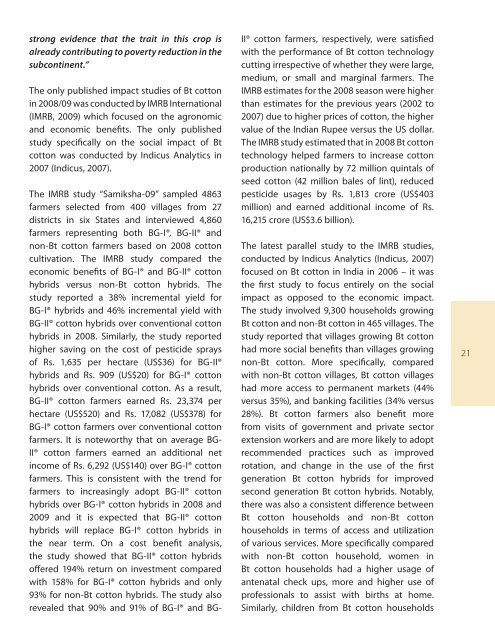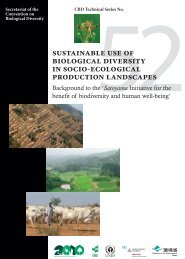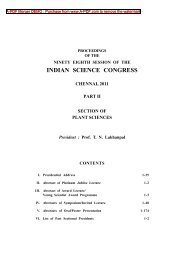A COUNTRY PROFILE Bt CoËon In India - India Environment Portal
A COUNTRY PROFILE Bt CoËon In India - India Environment Portal
A COUNTRY PROFILE Bt CoËon In India - India Environment Portal
You also want an ePaper? Increase the reach of your titles
YUMPU automatically turns print PDFs into web optimized ePapers that Google loves.
strong evidence that the trait in this crop is<br />
already contributing to poverty reduction in the<br />
subcontinent.”<br />
The only published impact studies of <strong>Bt</strong> cotton<br />
in 2008/09 was conducted by IMRB <strong>In</strong>ternational<br />
(IMRB, 2009) which focused on the agronomic<br />
and economic benefits. The only published<br />
study specifically on the social impact of <strong>Bt</strong><br />
cotton was conducted by <strong>In</strong>dicus Analytics in<br />
2007 (<strong>In</strong>dicus, 2007).<br />
The IMRB study “Samiksha-09” sampled 4863<br />
farmers selected from 400 villages from 27<br />
districts in six States and interviewed 4,860<br />
farmers representing both BG-I®, BG-II® and<br />
non-<strong>Bt</strong> cotton farmers based on 2008 cotton<br />
cultivation. The IMRB study compared the<br />
economic benefits of BG-I® and BG-II® cotton<br />
hybrids versus non-<strong>Bt</strong> cotton hybrids. The<br />
study reported a 38% incremental yield for<br />
BG-I® hybrids and 46% incremental yield with<br />
BG-II® cotton hybrids over conventional cotton<br />
hybrids in 2008. Similarly, the study reported<br />
higher saving on the cost of pesticide sprays<br />
of Rs. 1,635 per hectare (US$36) for BG-II®<br />
hybrids and Rs. 909 (US$20) for BG-I® cotton<br />
hybrids over conventional cotton. As a result,<br />
BG-II® cotton farmers earned Rs. 23,374 per<br />
hectare (US$520) and Rs. 17,082 (US$378) for<br />
BG-I® cotton farmers over conventional cotton<br />
farmers. It is noteworthy that on average BG-<br />
II® cotton farmers earned an additional net<br />
income of Rs. 6,292 (US$140) over BG-I® cotton<br />
farmers. This is consistent with the trend for<br />
farmers to increasingly adopt BG-II® cotton<br />
hybrids over BG-I® cotton hybrids in 2008 and<br />
2009 and it is expected that BG-II® cotton<br />
hybrids will replace BG-I® cotton hybrids in<br />
the near term. On a cost benefit analysis,<br />
the study showed that BG-II® cotton hybrids<br />
offered 194% return on investment compared<br />
with 158% for BG-I® cotton hybrids and only<br />
93% for non-<strong>Bt</strong> cotton hybrids. The study also<br />
revealed that 90% and 91% of BG-I® and BG-<br />
II® cotton farmers, respectively, were satisfied<br />
with the performance of <strong>Bt</strong> cotton technology<br />
cutting irrespective of whether they were large,<br />
medium, or small and marginal farmers. The<br />
IMRB estimates for the 2008 season were higher<br />
than estimates for the previous years (2002 to<br />
2007) due to higher prices of cotton, the higher<br />
value of the <strong>In</strong>dian Rupee versus the US dollar.<br />
The IMRB study estimated that in 2008 <strong>Bt</strong> cotton<br />
technology helped farmers to increase cotton<br />
production nationally by 72 million quintals of<br />
seed cotton (42 million bales of lint), reduced<br />
pesticide usages by Rs. 1,813 crore (US$403<br />
million) and earned additional income of Rs.<br />
16,215 crore (US$3.6 billion).<br />
The latest parallel study to the IMRB studies,<br />
conducted by <strong>In</strong>dicus Analytics (<strong>In</strong>dicus, 2007)<br />
focused on <strong>Bt</strong> cotton in <strong>In</strong>dia in 2006 – it was<br />
the first study to focus entirely on the social<br />
impact as opposed to the economic impact.<br />
The study involved 9,300 households growing<br />
<strong>Bt</strong> cotton and non-<strong>Bt</strong> cotton in 465 villages. The<br />
study reported that villages growing <strong>Bt</strong> cotton<br />
had more social benefits than villages growing<br />
non-<strong>Bt</strong> cotton. More specifically, compared<br />
with non-<strong>Bt</strong> cotton villages, <strong>Bt</strong> cotton villages<br />
had more access to permanent markets (44%<br />
versus 35%), and banking facilities (34% versus<br />
28%). <strong>Bt</strong> cotton farmers also benefit more<br />
from visits of government and private sector<br />
extension workers and are more likely to adopt<br />
recommended practices such as improved<br />
rotation, and change in the use of the first<br />
generation <strong>Bt</strong> cotton hybrids for improved<br />
second generation <strong>Bt</strong> cotton hybrids. Notably,<br />
there was also a consistent difference between<br />
<strong>Bt</strong> cotton households and non-<strong>Bt</strong> cotton<br />
households in terms of access and utilization<br />
of various services. More specifically compared<br />
with non-<strong>Bt</strong> cotton household, women in<br />
<strong>Bt</strong> cotton households had a higher usage of<br />
antenatal check ups, more and higher use of<br />
professionals to assist with births at home.<br />
Similarly, children from <strong>Bt</strong> cotton households<br />
21

















